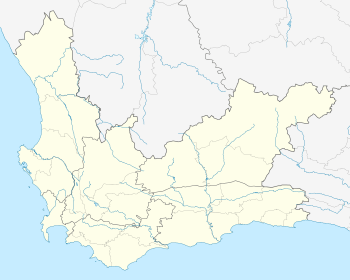Pearly Beach
Pearly Beach is a village in Overberg District Municipality in the Western Cape Province of South Africa.
Pearly Beach | |
|---|---|
 Pearly Beach  Pearly Beach | |
| Coordinates: 34.665°S 19.501°E | |
| Country | South Africa |
| Province | Western Cape |
| District | Overberg |
| Municipality | Overstrand |
| Area | |
| • Total | 3.92 km2 (1.51 sq mi) |
| Population (2011)[1] | |
| • Total | 1,042 |
| • Density | 270/km2 (690/sq mi) |
| Racial makeup (2011) | |
| • Black African | 48.2% |
| • Coloured | 11.9% |
| • White | 39.0% |
| • Other | 0.9% |
| First languages (2011) | |
| • Afrikaans | 45.5% |
| • Xhosa | 44.3% |
| • English | 9.1% |
| • Other | 1.1% |
| Time zone | UTC+2 (SAST) |
| Postal code (street) | 7220 |
| PO box | 7221 |
| Area code | 028 |
An area where the to southern right whale (Eubalaena australis) come to calve and mate along its migratory route (June – October). These whales can be seen with their young all along the coast line with Walker Bay just a short distance away. The area is home to the threatened African oystercatcher which can be seen on the rocky coasts, beaches and at lagoons eating limpets and mussels. It is close to Bantamsklip which was a proposed site of a nuclear power station. However,Thyspunt in the Eastern Cape seems to be the most likely location.
Geography
Not far from Pearly Beach is Dyers Island, a breeding colony for jackass penguins. Not far from Dyers Island is Geyser Island, a breeding ground for seals.
As the area around these Islands teems with an abundance of sea life, it has become a notorious feeding ground for the Great White shark which frequents its waters in large numbers.
Dyers Island is named after Samson Dyer, an American who came to the Cape in 1806, and who lived on Dyers Island where he collected guano for fertilizer.
References
- "Main Place Pearly Beach". Census 2011.
| Wikimedia Commons has media related to Pearly Beach. |
.svg.png)